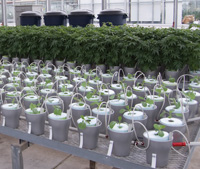
The trip from the greenhouse to a garden centre can damage plants,
causing them to lose their esthetic appeal and selling potential.
The trip from the greenhouse to a garden centre can damage plants, causing them to lose their esthetic appeal and selling potential. Especially vulnerable are plants that are too tall, where the stalks and leaves can bend and break when packed into a transport truck and driven a considerable distance.

|
|
| University of Guelph researchers Dr. Theo Blom and Dave Kerec. PHOTOS COURTESY SPARK, U OF GUELPH Advertisement
|
University of Guelph researchers are testing different ways to control plant height, while maintaining quality and esthetics.
Commercially registered growth retardants are traditionally used to control plant height. But it’s now feared these products could either be removed from the market (by manufacturers not renewing registration), or they will be eliminated for use by Health Canada.
As well, concerns are being raised about potential side effects from growth retardants.
To address the matter, Prof. Theo Blom, from the department of plant agriculture, and research technician David Kerec are trying alternative methods for controlling plant height.
“Changing nutrient ratios is one of the easier non-chemical methods to use and study for plant height control,” says Blom. “Other non-chemical methods such as brushing – repeated and frequent plant movement – can spread disease from plant to plant and cause more harm than good.”
WHY CONTROLLING SIZE IS SO IMPORTANT
■ Many box or retail stores, which comprise a crucial market for garden plants, have specific dimensions for the plants they’re acquiring. Producers usually ship the plants in boxes that are tightly stacked in a transport truck; it’s in their best interest to gain control over the size of their plants.
 |
|
| Height control experiment setup. PHOTOS COURTESY SPARK, U OF GUELPH |
“If the plants are 40 centimetres tall versus 60 centimetres, a producer can ship 50 per cent more plants per load,” says Blom.
He and Kerec are using different nutrient ratios of the three major macronutrients – nitrogen (both nitrate and ammonium forms), phosphorus and potassium – to see which ratio works best for keeping plants short. Plants use these nutrients in large quantities for growth and survival, and understanding how various quantities influence plant height will provide alternative ways for greenhouse producers to keep growth under control.
In the greenhouse, Blom and Kerec have mixed 54 different macronutrient solutions. Their test species are marigolds, salvia and tomatoes.
USING HYDROPONIC SYSTEMS TO MONITOR THE ROOTS
■ The first run of the experiment is now underway with 27 of the 54 nutrient solutions. The researchers are using hydroponic systems so they can easily monitor the root systems. Hydroponics was chosen for simplicity – it removes the risk of the soil drying out, which adds another factor to control. It’s also easier to manage eliminating the daily watering requirements.
Once all 54 solutions have been tested, Blom and Kerec will use the concentration they find that limits plant growth as the control. Their next step will be to employ three different salt concentrations to see if a low, medium or high concentration has the most influence over plant height.
Blom hopes to provide greenhouse operators with the ideal macronutrient ratios and salt concentrations to manipulate plant height without chemicals. This will allow producers to control plant height and ensure optimal shipping conditions to retailers, without the losses incurred from damaged plants.
Above all, Blom wants to ensure growers can deliver the high value product consumers expect. “Hopefully, producers will be able to keep their plants short without affecting flowering or yield.”
Dr. Xiuming Hao, a research scientist from Agriculture and Agri-Food Canada’s Greenhouse and Processing Crops Research Centre in Harrow, Ontario, is also involved in this project, and will concentrate on vegetable transplants.
Moore is a student writer with the SPARK (Students Promoting Awareness of Research Knowledge) program at the University of Guelph.
Print this page